The Home Energy Management Systems Market is estimated to be valued at USD 4.0 billion in 2025 and is projected to reach USD 20.4 billion by 2035, registering a compound annual growth rate (CAGR) of 17.7% over the forecast period.
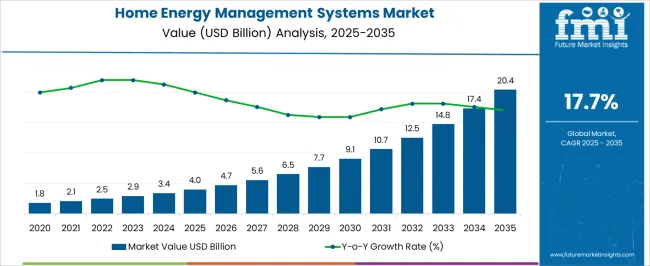
| Metric | Value |
|---|---|
| Home Energy Management Systems Market Estimated Value in (2025 E) | USD 4.0 billion |
| Home Energy Management Systems Market Forecast Value in (2035 F) | USD 20.4 billion |
| Forecast CAGR (2025 to 2035) | 17.7% |
The home energy management systems market is experiencing accelerated growth driven by rising energy costs, increasing adoption of smart home technologies, and global emphasis on energy efficiency. Consumers are prioritizing solutions that provide real time monitoring, automation, and optimization of household energy consumption.
Government incentives and regulatory frameworks promoting energy conservation and integration of renewable energy sources are reinforcing adoption trends. Advancements in wireless connectivity, cloud platforms, and AI enabled analytics are improving system performance, enabling predictive insights and user friendly interfaces.
Growing consumer interest in reducing carbon footprints and enhancing household sustainability is further fueling market expansion. The outlook remains promising as home energy management systems become central to connected living ecosystems, aligning with the broader transition toward smart, energy efficient homes.
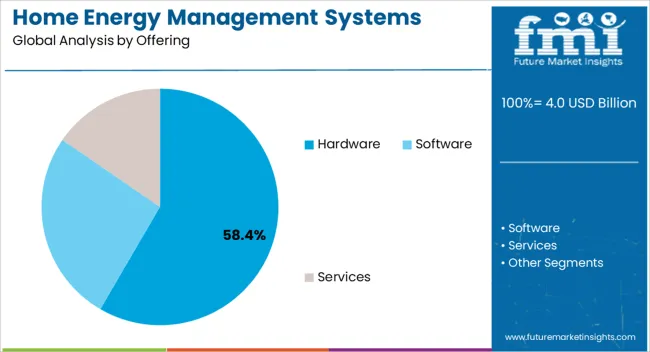
The hardware segment is projected to account for 58.40% of total revenue by 2025 within the offering category, making it the leading segment. This is attributed to increasing adoption of smart meters, sensors, and control devices that enable effective monitoring and management of household energy usage.
Hardware components serve as the foundation for integration with software platforms, allowing real time tracking and automation. Rising demand for connected appliances and home automation solutions has further accelerated deployment of hardware devices.
As consumers prioritize efficient energy utilization and system interoperability, the hardware segment continues to dominate due to its essential role in enabling end to end energy management.
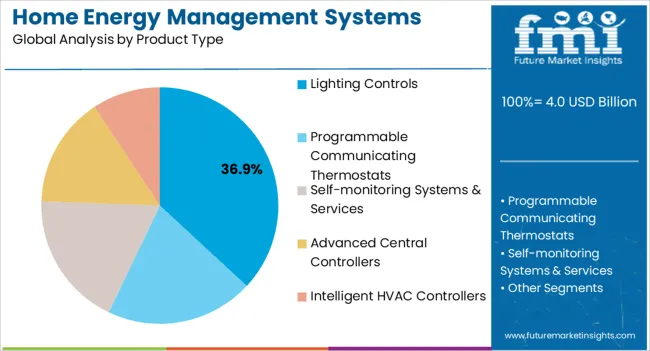
The lighting controls segment is expected to represent 36.90% of market revenue by 2025 under the product type category, positioning it as the most prominent product type. This growth is supported by increasing adoption of energy efficient lighting systems and growing consumer preference for automation features.
Lighting controls enable users to optimize energy consumption through dimming, occupancy sensing, and daylight harvesting technologies. Their compatibility with smart home ecosystems and contribution to significant energy savings have strengthened their adoption.
As awareness regarding sustainability and smart living increases, lighting controls remain at the forefront of product type demand within the market.
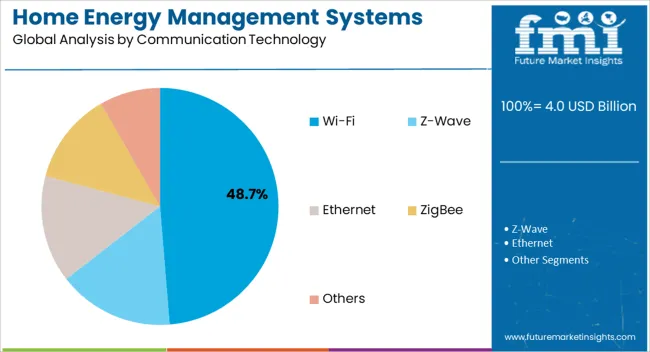
The Wi Fi segment is projected to capture 48.70% of total market revenue by 2025 within the communication technology category, making it the leading segment. This dominance is attributed to the widespread availability of Wi Fi networks and consumer familiarity with the technology.
Wi Fi based systems allow seamless integration with smartphones and other connected devices, supporting remote monitoring and control. Flexibility, scalability, and cost effectiveness of Wi Fi technology have made it a preferred choice for home energy management system deployment.
With increasing reliance on wireless connectivity and growth in smart device penetration, Wi Fi continues to lead the communication technology segment, ensuring reliable and user friendly energy management solutions.
| Market CAGR (2020 to 2025) | 6.3% |
|---|---|
| Market Size (2020) | USD 1,283.8 million |
| Market Size (2025) | USD 2,451.2 million |
| Market Growth Rate (between 2025 and 2025) | 1.17x |
Energy management strategies have undergone a revolutionary transformation. This is regarding many sectors of power consumption, such as electricity usage patterns and energy conservation at consumption premises.
A smart home energy management system that significantly increases efficiency is required for a modern home. This raised the global adoption rate to 1.17x between 2025 and 2025.
According to FMI, domestic energy consumption is likely to increase by 0.3% annually by 2035. Consequently, home energy management systems sales are expected to be supported by energy optimization solutions, such as a smart home's electrical board.
The worldwide EMS market is anticipated to hold a sizable market share for the home energy management systems industry share. Smart building development is accelerating urbanization in developing nations. Like China, India, Japan, Argentina, Mexico, Brazil, and South Korea.
The knowledge of housing development in these nations has led to an increase in demand for better housing infrastructure. As home energy management software is used in newly constructed buildings, the global market is likely to reach USD 9,050.4 million by 2035.
Manufacturers and suppliers of home energy management systems are concentrating on power storage, control, and monitoring. Key players' top priorities are energy independence and automation, and developments are moving in this direction.
For instance: Schneider Electric is the industry leader in the digital transformation of energy management and automation. For homes looking for cost savings, comfort, and energy independence, the company introduced Schneider Home, a ground-breaking home energy management solution.
Like any industry, this one also faces challenges. The global market growth is significantly constrained by the high initial cost associated with adopting energy management systems. However, the government's push for smart house development is anticipated to open doors for the home energy management systems sector.
Governments are crucial in promoting energy-saving efforts and the installation of smart buildings. Regulations and policies have been devised to improve energy efficiency and reduce a building's consumption of renewable energy, home HVAC systems, and lighting.
| Countries | Market Share (2025) |
|---|---|
| United States | 16.5% |
| Australia | 2.7% |
| Germany | 7.1% |
| Japan | 5.4% |
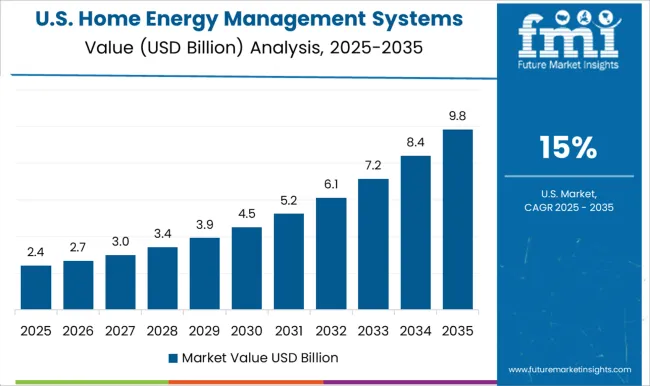
By 2035, the home energy management systems market share is predicted to generate a sizable amount of revenue in the United States. This is due to technological improvements and the growing use of wireless technologies like ZigBee, Wi-Fi, and Z-wave. The regional sector is also made stronger by the rising demand for home LAN hardware.
Home energy management systems companies are also pleading with the government to expand existing programs and seek funding. Also, a lot of the organizations are concentrating on leveraging funding from the bipartisan Infrastructure Investment and the American Rescue Plan Act of 2024. As a result, the market under study is anticipated to benefit from this requirement for energy efficiency.
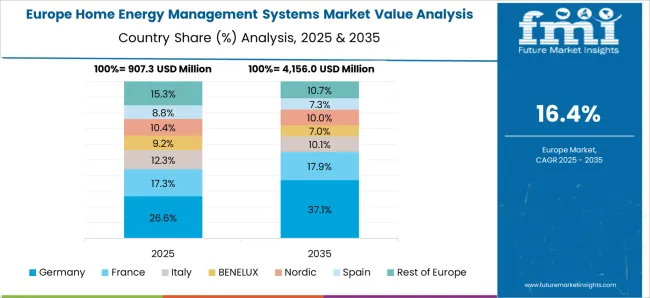
By implementing the National Action Plan Energy Efficiency strategy, the German government is on track to rank among the world's leading eco-friendly and energy-efficient nations.
Funding plans for energy audits and efficiency measures are covered. The nation intends to lower its usage of primary energy by 30% by 2035 compared to 2008 levels, according to the Ministry for Economic Affairs.
Since 2010, Germany has placed a priority on long-term, sustainable energy. A strategy plan known as the Energy Concept was adopted by the nation for the use of renewable energy. This plan lays the groundwork for a renewable energy-based route that is focused on the year 2050.
Market leaders focus on supportive energy policies and laws aimed at lowering the nation's carbon footprint. Implementation of smart meters and energy-efficient buildings & systems contributes to the sales of home energy management systems.
Energy providers are required to put smart meters in 26 million homes by the United Kingdom government. The European directive is to reduce carbon emissions by 80% by 2050, along with the increasing smart meter rollout and increased awareness of the energy problem.
| Countries | Market CAGR (2025 to 2035) |
|---|---|
| China | 15.4% |
| India | 16.7% |
The quantity of investments made has also been increasing in the Asia Pacific area. Between 2020 and 2024, the average annual energy investment in the region was around USD 70,000 million, of which 40% went to clean energy technologies. The main investments involved in grids, solar, and wind energy. Due to the rising use of smart home technology in nations like China and India, Asia Pacific is anticipated to have considerable growth over the forecast period.
| Category | Communication Technology |
|---|---|
| Top Segment | Wi-Fi |
| Market Share (2025) | 26.5% |
| Category | Offering |
|---|---|
| Top Segment | Hardware |
| Market Share (2025) | 38.9% |
In 2025, the hardware sector held the leading market share of 26.5%. This is explained by the increased use of communication and sensor technology. Nonetheless, the software plays a key role in reducing energy consumption and providing data on consumption trends. Software components are more popular now since they provide useful energy data insights that are used to cut costs and streamline processes.
By 2035, WiFi communication technology is anticipated to rule the market. In recent years, WiFi technology has advanced substantially, resulting in quicker speeds and higher reliability. Due to this, it has become simpler for manufacturers to create HEMS systems that offer real-time data and control functions without calling for challenging installations.
As ZigBee modules are frequently used to monitor the energy usage of residential appliances, the ZigBee-powered market is expected to expand significantly. ZigBee is a widely used wireless, low-power mesh networking protocol that enables users with smaller batteries and is utilized in wireless control applications.
Home energy management systems manufacturers are anticipated to expand their market share. By creating innovative products that cater to consumers' shifting demands and preferences. This entails enhancing functionality, cutting expenses, and adding new features.
Manufacturers aim to spend money on customer education and awareness initiatives to increase acceptance. This clarifies the benefits of home energy management systems and how they are used to save energy and money.
Manufacturers who create AI and ML capabilities that can react to shifting consumer preferences and energy usage trends are going to have a big competitive edge.
For instance:
Globally, the smart home has become popular, inspiring top home energy management systems businesses to develop technology alliances and take a strategic stance. Home energy management systems are a significant emerging industry due to the growing IoT trend.
Several government organizations want to use product approvals to encourage the adoption of these systems. To get a competitive edge during the forecast period, the firms are anticipated to expand their market share through many alliances and investments in the introduction of new solutions.
Recent Developments:
January 2025: To penetrate the global smart home market, Zigbang announced the acquisition of Samsung SDS's home Internet of Things (IoT) unit. The former is preparing to automate real estate transactions, smart home gadgets, and living spaces.
September 2025: A highly scalable Linux and Kubernetes-based platform designed to execute thousands of workloads on a single system was unveiled as the new edition of IBM's LinuxONE server.
August 2024: A contract was signed by Mitsubishi Electric Company to purchase Smarter Grid Solutions (SGS). SGS solutions, according to Mitsubishi Electric, are consistent with the company's environmental sustainability vision. This calls for a decarbonized society with lower greenhouse gas emissions by 2050.
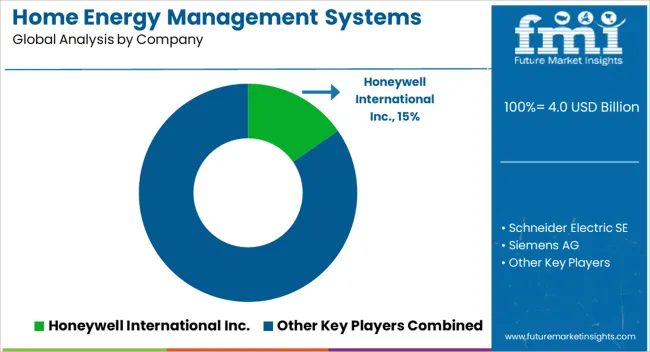
The global home energy management systems market is estimated to be valued at USD 4.0 billion in 2025.
The market size for the home energy management systems market is projected to reach USD 20.4 billion by 2035.
The home energy management systems market is expected to grow at a 17.7% CAGR between 2025 and 2035.
The key product types in home energy management systems market are hardware, software and services.
In terms of product type, lighting controls segment to command 36.9% share in the home energy management systems market in 2025.






Our Research Products

The "Full Research Suite" delivers actionable market intel, deep dives on markets or technologies, so clients act faster, cut risk, and unlock growth.

The Leaderboard benchmarks and ranks top vendors, classifying them as Established Leaders, Leading Challengers, or Disruptors & Challengers.

Locates where complements amplify value and substitutes erode it, forecasting net impact by horizon

We deliver granular, decision-grade intel: market sizing, 5-year forecasts, pricing, adoption, usage, revenue, and operational KPIs—plus competitor tracking, regulation, and value chains—across 60 countries broadly.

Spot the shifts before they hit your P&L. We track inflection points, adoption curves, pricing moves, and ecosystem plays to show where demand is heading, why it is changing, and what to do next across high-growth markets and disruptive tech

Real-time reads of user behavior. We track shifting priorities, perceptions of today’s and next-gen services, and provider experience, then pace how fast tech moves from trial to adoption, blending buyer, consumer, and channel inputs with social signals (#WhySwitch, #UX).

Partner with our analyst team to build a custom report designed around your business priorities. From analysing market trends to assessing competitors or crafting bespoke datasets, we tailor insights to your needs.
Supplier Intelligence
Discovery & Profiling
Capacity & Footprint
Performance & Risk
Compliance & Governance
Commercial Readiness
Who Supplies Whom
Scorecards & Shortlists
Playbooks & Docs
Category Intelligence
Definition & Scope
Demand & Use Cases
Cost Drivers
Market Structure
Supply Chain Map
Trade & Policy
Operating Norms
Deliverables
Buyer Intelligence
Account Basics
Spend & Scope
Procurement Model
Vendor Requirements
Terms & Policies
Entry Strategy
Pain Points & Triggers
Outputs
Pricing Analysis
Benchmarks
Trends
Should-Cost
Indexation
Landed Cost
Commercial Terms
Deliverables
Brand Analysis
Positioning & Value Prop
Share & Presence
Customer Evidence
Go-to-Market
Digital & Reputation
Compliance & Trust
KPIs & Gaps
Outputs
Full Research Suite comprises of:
Market outlook & trends analysis
Interviews & case studies
Strategic recommendations
Vendor profiles & capabilities analysis
5-year forecasts
8 regions and 60+ country-level data splits
Market segment data splits
12 months of continuous data updates
DELIVERED AS:
PDF EXCEL ONLINE
Energy Management System Market Analysis – Growth & Forecast 2017-2025
Home Brewing Systems Market Size and Share Forecast Outlook 2025 to 2035
Home Dialysis Systems Market Size and Share Forecast Outlook 2025 to 2035
Energy Portfolio Management Market Report – Trends & Forecast 2023-2033
Cloud Systems Management Software Market Size and Share Forecast Outlook 2025 to 2035
Homecare Dermatology Energy-based Devices Market Growth – Trends & Forecast 2018-2028
Systems Administration Management Tools Market Size and Share Forecast Outlook 2025 to 2035
Building Energy Management Solutions Market Size and Share Forecast Outlook 2025 to 2035
Industrial Energy Management System Market Size and Share Forecast Outlook 2025 to 2035
Remote Home Monitoring Systems Market Size and Share Forecast Outlook 2025 to 2035
Battlefield Management Systems Market Size and Share Forecast Outlook 2025 to 2035
Translation Management Systems Market Analysis - Size, Share, and Forecast Outlook 2025 to 2035
New Energy Vehicle Electric Drive Systems Market Size and Share Forecast Outlook 2025 to 2035
Automotive Energy Recovery Systems Market Size and Share Forecast Outlook 2025 to 2035
Environmental Management Systems Market Size and Share Forecast Outlook 2025 to 2035
Directed Energy-Based Surgical Systems Market Growth – Forecast 2025 to 2035
AGV Intelligent Management Systems Market Size and Share Forecast Outlook 2025 to 2035
Endoscopy Fluid Management Systems Market Size and Share Forecast Outlook 2025 to 2035
Retail Warehouse Management Systems Market Size and Share Forecast Outlook 2025 to 2035
Train Control and Management Systems Market Size and Share Forecast Outlook 2025 to 2035

Thank you!
You will receive an email from our Business Development Manager. Please be sure to check your SPAM/JUNK folder too.
Chat With
MaRIA